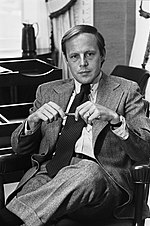
John Dean
American lawyer, politician
American electrical engineer and science administrator (1890-1974)
Vannevar Bush was an American engineer, inventor, and science administrator who played a crucial role during World War II. He headed the U.S. Office of Scientific Research and Development, oversaw the development of important military technologies, and was instrumental in the creation of the National Science Foundation.
Table of Contents
Vannevar Bushwas an American engineer, inventor and science administrator, who during World War II headed the U.S. Office of Scientific Research and Developmentin 1919, and founded the company that became the Raytheon Company in 1922. Bush became vice president of MIT and dean of the MIT School of Engineering in 1932, and president of the Carnegie Institution of Washington in 1938.
During his career, Bush patented a string of his own inventions. He is known particularly for his engineering work on analog computers, and for the memex. Starting in 1927, Bush constructed a differential analyzer, a mechanical analog computer with some digital components that could solve differential equations with as many as 18 independent variables. An offshoot of the work at MIT by Bush and others was the beginning of digital circuit design theory. The memex, which he began developing in the 1930swas a hypothetical adjustable microfilm viewer with a structure analogous to that of hypertext. The memex and Bush’s 1945 essay “As We May Think” influenced generations of computer scientists, who drew inspiration from his vision of the future.
Bush was appointed to the National Advisory Committee for Aeronauticsin 1938, and soon became its chairman. As chairman of the National Defense Research Committee (NDRC), and later director of OSRD, Bush coordinated the activities of some six thousand leading American scientists in the application of science to warfare. Bush was a well-known policymaker and public intellectual during World War II, when he was in effect the first presidential science advisor. As head of NDRC and OSRD, he initiated the Manhattan Project, and ensured that it received top priority from the highest levels of government. In Science, The Endless Frontier, his 1945 report to the president of the United States, Bush called for an expansion of government support for science, and he pressed for the creation of the National Science Foundation.
During World War II, Vannevar Bush headed the U.S. Office of Scientific Research and Development (OSRD), which oversaw the development of important military technologies, including radar and the Manhattan Project.
The memex was a hypothetical adjustable microfilm viewer developed by Vannevar Bush in the 1930s, which had a structure similar to hypertext. The memex and Bush’s 1945 essay ,As We May Think, inspired generations of computer scientists with his vision of the future.
Vannevar Bush was chiefly responsible for the movement that led to the creation of the National Science Foundation. In his 1945 report ,Science, The Endless Frontier,, he called for an expansion of government support for science, which paved the way for the establishment of the National Science Foundation.
Vannevar Bush was an accomplished engineer and inventor. He patented a string of his own inventions, including work on analog computers and the differential analyzer, a mechanical analog computer that could solve differential equations.
Vannevar Bush was appointed to the National Advisory Committee for Aeronautics (NACA) in 1938 and soon became its chairman. The NACA was an important organization that helped guide the development of aviation technology in the United States.
The scene changes but the aspirations of men of good will persist.
American electrical engineer and science administrator (1890-1974)
Science has a simple faith, which transcends utility. It is the faith that it is the privilege of man to learn to understand, and that this is his mission.
American electrical engineer and science administrator (1890-1974)
Fear cannot be banished, but it can be calm and without panic; it can be mitigated by reason and evaluation.
American electrical engineer and science administrator (1890-1974)
A belief may be larger than a fact.
American electrical engineer and science administrator (1890-1974)
To pursue science is not to disparage the things of the spirit. In fact, to pursue science rightly is to furnish the framework on which the spirit may rise.
American electrical engineer and science administrator (1890-1974)
If scientific reasoning were limited to the logical processes of arithmetic, we should not get very far in our understanding of the physical world. One might as well attempt to grasp the game of poker entirely by the use of the mathematics of probability.
American electrical engineer and science administrator (1890-1974)